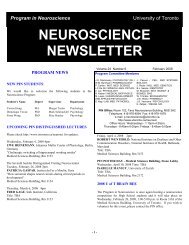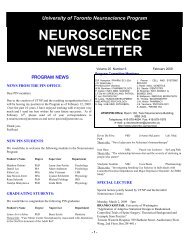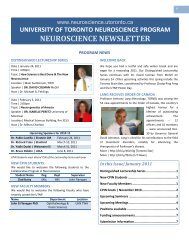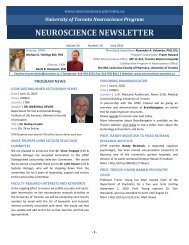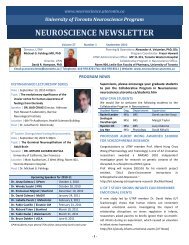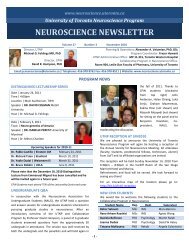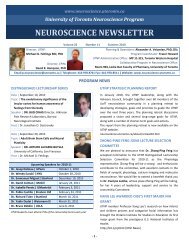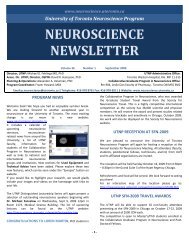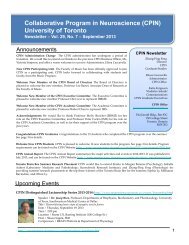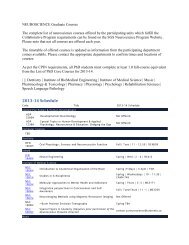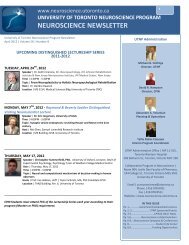Volume 23 Number 02 - Program in Neuroscience, University of ...
Volume 23 Number 02 - Program in Neuroscience, University of ...
Volume 23 Number 02 - Program in Neuroscience, University of ...
Create successful ePaper yourself
Turn your PDF publications into a flip-book with our unique Google optimized e-Paper software.
<strong>Program</strong> <strong>in</strong> <strong>Neuroscience</strong><br />
<strong>University</strong> <strong>of</strong> Toronto<br />
NEUROSCIENCE<br />
NEWSLETTER<br />
NEW PIN STUDENTS:<br />
PROGRAM NEWS<br />
We would like to welcome the follow<strong>in</strong>g students to the<br />
<strong>Neuroscience</strong> <strong>Program</strong>:<br />
Student’s Name Degree Supervisor Department<br />
L<strong>in</strong>a Chiuccariello MSc Usoa Busto Pharmacology<br />
Beverly Francis MSc Howard Mount Physiology<br />
Sabiha Gardezi MSc Elise Stanley Physiology<br />
Hiroyuki J<strong>in</strong>no MSc Freda Miller Physiology<br />
Krist<strong>in</strong> Johnson MSc Mart<strong>in</strong> Wojtowicz Physiology<br />
Liam Kaufman Simpk<strong>in</strong>s MSc Sandra Black IMS<br />
Greer Kirshenbaum MSc John Roder IMS<br />
Vladyslav Kushnir MSc Usoa Busto Pharmacology<br />
Alonso Mart<strong>in</strong>ez Canabal PhD Paul Frankland IMS<br />
Patrick McCormick PhD Philip Seeman IMS<br />
Saba Mir MSc John Peever Cell & Sys Bio<br />
Andreea Moraru MSc Isabelle Aubert Lab. Med. Path.<br />
Won Hyung A. Ryu MSc Deirdre Dawson Rehab. Sci.<br />
Jessica Sturgess MSc D. van der Kooy Med. Biophysics<br />
GRADUATING STUDENTS:<br />
We would like to congratulate the follow<strong>in</strong>g PIN graduates:<br />
Student’s Name Degree Supervisor Department<br />
Glad Bejat MSc Barry Sessle Dentistry<br />
Thesis title: "Sensory modulation <strong>of</strong> rat lick<strong>in</strong>g behaviour"<br />
Ryan Brydges MSc Adam Dubrowski IMS<br />
Thesis title: "Sensorimotor <strong>in</strong>tegration: Prehensile movements <strong>in</strong> conditions<br />
<strong>of</strong> visuo-proprioceptive conflict"<br />
Martha McCall MSc Deirdre Dawson Rehab. Science<br />
Thesis title: "A Modified Constra<strong>in</strong>t Induced Movement Therapy <strong>Program</strong><br />
with the Geriatric Sub Acute Stroke Population"<br />
<strong>Volume</strong> <strong>23</strong> <strong>Number</strong> 2 October 2006<br />
<strong>Program</strong> Committee Members<br />
J.O. Dostrovsky / PHYSIOLOGY (Dir.)<br />
W.M. Burnham / PHARMACOLOGY<br />
P. Carlen / INST. MED. SCIENCE<br />
L.F.De Nil / SPEECH LANG. PATHOL.<br />
M. Fehl<strong>in</strong>gs / KREMBIL NEURO.<br />
CENTRE, UHN<br />
Z. Jia / PHYSIOLOGY<br />
N. Kabani / MEDICAL BIOPHYSICS<br />
M. Lewis / HUMAN DEVELOPMENT<br />
AND APPLIED PSYCHOLOGY<br />
W. McIlroy / REHAB. SCI.<br />
J. Peever/CELL AND SYSTEMS<br />
BIOLOGY.<br />
Nag / LAB. MED. PATHOBIOL.<br />
J. Roder / MOL. MED. GENETICS<br />
B.J. Sessle / DENTISTRY<br />
M. Shoichet / INST. BIOMAT. &<br />
BIOMED. ENG.<br />
E. Stanley / CELL. & MOL. BIO.<br />
DIV.,TWRI<br />
W. Trimble / BIOCHEMISTRY<br />
J.W. Wells / PHARMACY<br />
J.S. Yeomans / PSYCHOLOGY<br />
PIN Office: Room 1<strong>02</strong>, Tanz <strong>Neuroscience</strong> Build<strong>in</strong>g, M5S 3H2.<br />
Telephone: 416-978-4894 Fax: 416-978-1878<br />
e-mail: p.neuroscience@utoronto.ca.<br />
http://www.utoronto.ca/neurosci<br />
Office Hours: Wednesdays - 1:15pm-5:00pm;<br />
Thursdays - 8:45am-5:00pm; Fridays - 8:45am-5:00pm<br />
Jennie Yum MSc Michael Tymianski IMS<br />
Thesis title: "Role <strong>of</strong> the PDZ-b<strong>in</strong>d<strong>in</strong>g motif <strong>of</strong> TRPM7 <strong>in</strong> mediat<strong>in</strong>g<br />
calcium-dependent cellular degeneration <strong>in</strong>duced by chemical anoxia"<br />
UPCOMING PIN DISTINGUISHED LECTURES<br />
The Sixth Sackler Dist<strong>in</strong>guished Visit<strong>in</strong>g Neuroscientist<br />
Thursday, October 26, 2006 4pm<br />
JACK FELDMAN, PhD, Department <strong>of</strong> Neurobiology, UCLA<br />
School <strong>of</strong> Medic<strong>in</strong>e<br />
"Look<strong>in</strong>g for <strong>in</strong>spiration: New perspectives on the generation <strong>of</strong><br />
respiratory rhythm"<br />
Medical Sciences Build<strong>in</strong>g, Rm 3154<br />
Thursday, December 7, 2006 4pm<br />
JEROME SIEGEL, Department <strong>of</strong> Psychiatry, <strong>University</strong> <strong>of</strong><br />
California at Los Angeles<br />
Title: TBA<br />
Medical Sciences Build<strong>in</strong>g, Rm 3153<br />
- 1 -
Wednesday, December 13, 2006 3pm<br />
DAVID SWEATT, Department <strong>of</strong> <strong>Neuroscience</strong>, Baylor College <strong>of</strong><br />
Medic<strong>in</strong>e, Houston, Texas<br />
Title: TBA<br />
Mount S<strong>in</strong>ai Hospital, 18th Floor Auditorium<br />
PIN STUDENT HONOURS AND AWARDS<br />
Rob Bon<strong>in</strong> (PhD Candidate, Orser lab) was awarded a K.M. Hunter<br />
Graduate Scholarship from the Faculty <strong>of</strong> Medic<strong>in</strong>e, <strong>University</strong> <strong>of</strong><br />
Toronto. The award is worth $20,000 and beg<strong>in</strong>s <strong>in</strong> September 2006.<br />
The committee unanimously recommended Rob as the top candidate.<br />
Many congratulations to Rob!<br />
Natalya Shulyakova (MSc, Mills lab) won a Microscopy Society <strong>of</strong><br />
Canada GT Simon Award to travel to the Microscopy Society <strong>of</strong><br />
America 2006 meet<strong>in</strong>g <strong>in</strong> Chicago (this August) where she gave an<br />
<strong>in</strong>vited talk. She was previously awarded an MSA scholarship <strong>in</strong> 2005<br />
as an undergraduate.<br />
From Physiol<strong>in</strong>k, September 8, 2006<br />
ANDP FORUM for Students and Postdoctoral<br />
Tra<strong>in</strong>ees.<br />
“Strategies for Successful Transition to a <strong>Neuroscience</strong> Career” -<br />
Monday, October 16, 2006, 11:30 AM - 1:00 PM, Georgia World<br />
Congress Center, Room: A409<br />
Brief highlights from the recent ANDP survey on our Nation’s<br />
<strong>Neuroscience</strong> graduate students and postdoctoral fellows will be<br />
presented, followed by discussion with our panelists on how to steer<br />
tra<strong>in</strong><strong>in</strong>g to impact your career. More <strong>in</strong>formation on tra<strong>in</strong>ee outcomes<br />
can be found <strong>in</strong> our survey report at http://www.andp.org. Students<br />
and postdocs are encouraged to br<strong>in</strong>g questions for our panel!<br />
Moderator: Alison K. Hall, Ph.D. Case Western Reserve Univ.<br />
ANDP Survey Highlights: Edward Stricker, Ph.D. <strong>University</strong><br />
Pr<strong>of</strong>essor, Dept. <strong>Neuroscience</strong>, <strong>University</strong> <strong>of</strong> Pittsburgh<br />
Panelists: Nancy Ip, Ph.D. Director Biotechnology Research Institute<br />
Hong Kong <strong>University</strong> <strong>of</strong> Science and Technology (previously at<br />
Lifecodes Corp., and Regeneron Pharmaceuticals Inc.)<br />
Thomas Carew, Ph.D Pr<strong>of</strong>essor and Chair, Neurobiology and<br />
Behavior <strong>University</strong> <strong>of</strong> California, Irv<strong>in</strong>e<br />
Karl Johnson, Ph.D. Assistant Pr<strong>of</strong>essor, Biology and <strong>Neuroscience</strong>,<br />
Pomona College<br />
ANDP/SfN STUDENT HOSPITALITY SUITE. The suite is located<br />
<strong>in</strong> the Georgia World Congress Center room B213 and is open each<br />
day <strong>of</strong> the SfN meet<strong>in</strong>g from October 14 – 18. Please urge your<br />
students to take advantage <strong>of</strong> this quiet place to relax and socialize<br />
with other students. Details may be found at<br />
http://www.andp.org/meet<strong>in</strong>gs/2006/hospitality.htm.<br />
NOTICE TO GRADUATING STUDENTS<br />
Please notify the PIN <strong>of</strong>fice upon your graduation to ensure that you<br />
will receive the notation "completed Collaborative <strong>Program</strong> <strong>in</strong><br />
<strong>Neuroscience</strong>" on your degree transcript as well as a separate<br />
certificate suitable for fram<strong>in</strong>g from the PIN <strong>of</strong>fice to <strong>in</strong>dicate that<br />
you have completed the program's requirements. Please let the<br />
<strong>of</strong>fice know the address you wish your certificate sent to and please<br />
also send us your thesis title. If you have transferred from a<br />
Master’s degree to a Ph.D., please notify the PIN <strong>of</strong>fice.<br />
OTHER U <strong>of</strong> T NEUROSCIENCE NEWS<br />
Tanenbaum symposium<br />
This year's Tanenbaum symposium will focus on cognitive/mental<br />
health neuroscience.<br />
The symposium will be held on Friday, November 10, 2006, at the<br />
Health Sciences Build<strong>in</strong>g, 155 College Street, Rm 610, from 1:30 to<br />
4:00 pm, followed by a reception.<br />
The guest speaker will be Pr<strong>of</strong>essor Trevor Robb<strong>in</strong>s <strong>of</strong> Cambridge<br />
<strong>University</strong>. The three Tanenbaum chairs <strong>in</strong> this focus will also<br />
present: Pr<strong>of</strong>s. Endel Tulv<strong>in</strong>g, Phil Seeman and Terry Picton.<br />
This will also be an occasion to celebrate the beg<strong>in</strong>n<strong>in</strong>g <strong>of</strong> the<br />
<strong>University</strong> <strong>of</strong> Toronto Centre for <strong>Neuroscience</strong>.<br />
Please mark this date <strong>in</strong> your calendar.<br />
Conference Announcement<br />
Call for Abstracts<br />
‘Advances <strong>in</strong> Neurorehabilitation’<br />
http://toronto-fes.ibme.utoronto.ca/ANR/<strong>in</strong>dex.htm<br />
June 16-19, 2007<br />
Toronto, Canada<br />
Part <strong>of</strong> the Festival <strong>of</strong> International Conferences<br />
on Caregiv<strong>in</strong>g, Disability, Ag<strong>in</strong>g and Technology<br />
http://www.ficcdat.com<br />
Overview: New understand<strong>in</strong>g and technological advances are<br />
lead<strong>in</strong>g a revolution <strong>in</strong> therapeutic approaches to repair and / or<br />
m<strong>in</strong>imize disability and maximize function and well-be<strong>in</strong>g follow<strong>in</strong>g<br />
bra<strong>in</strong> and/or sp<strong>in</strong>al cord <strong>in</strong>jury. The conference will explore the<br />
physiologic pr<strong>in</strong>ciples that underp<strong>in</strong> these new therapies.<br />
Researchers and cl<strong>in</strong>icians will highlight state-<strong>of</strong>-the-art<br />
rehabilitation techniques and novel therapies focused on optimiz<strong>in</strong>g<br />
physical and cognitive abilities. The conference will also focus on<br />
new technologies to better assess changes <strong>in</strong> central nervous system<br />
function and human behaviour.<br />
Keynote speakers:<br />
Dr. Pamela Duncan, United States<br />
Dr. Gert Kwakkel, The Netherlands<br />
Dr. Randolph Nudo, United States<br />
- 2 -
Dr. John Steeves, Canada<br />
Call for Abstracts: Onl<strong>in</strong>e submission deadl<strong>in</strong>e - November 6, 2006<br />
(details on website)<br />
Onl<strong>in</strong>e Registration: Early bird registration - February 1, 2007 (details<br />
on website)<br />
Support<strong>in</strong>g organizations:<br />
Toronto Rehabilitation Institute<br />
Department <strong>of</strong> Physical Therapy, <strong>University</strong> <strong>of</strong> Toronto<br />
Ontario Neurotrauma Foundation<br />
Canadian Stroke Network<br />
Heart and Stroke Foundation <strong>of</strong> Ontario Centre for Stroke Recovery<br />
OTHER NEUROSCIENCE NEWS<br />
Society for <strong>Neuroscience</strong> Annual Meet<strong>in</strong>g<br />
Atlanta, Georgia<br />
M<strong>in</strong>isymposium: Theoretical <strong>Neuroscience</strong>: Model<strong>in</strong>g cells, circuits<br />
and behaviour<br />
Sunday, October 15, 2006 8:30-11am<br />
Chaired by Dr. Frances Sk<strong>in</strong>ner, Toronto Western Research<br />
Institute, Department <strong>of</strong> Physiology and <strong>Program</strong> <strong>in</strong> <strong>Neuroscience</strong>,<br />
<strong>University</strong> <strong>of</strong> Toronto<br />
Huge strides and advances <strong>in</strong> technology are be<strong>in</strong>g made these days<br />
allow<strong>in</strong>g us to peer <strong>in</strong>side cells and to measure microscopic details<br />
with<strong>in</strong> them – a wealth <strong>of</strong> data about the bra<strong>in</strong> and nervous system is<br />
be<strong>in</strong>g uncovered. However, with these advances, it is becom<strong>in</strong>g<br />
<strong>in</strong>creas<strong>in</strong>gly clear that we also need to devote energy toward<br />
understand<strong>in</strong>g the data <strong>in</strong> a framework beyond the scales <strong>in</strong> which<br />
they exist. For example, how do events that occur at the cellular level<br />
affect bra<strong>in</strong> circuitry and <strong>in</strong> turn shape behavior Enter model<strong>in</strong>g and<br />
theory. In other fields such as physics and chemistry, mathematics has<br />
been used as the language for describ<strong>in</strong>g elements and systems for<br />
centuries. As neuroscience (and biology <strong>in</strong> general) becomes more<br />
quantitative, we need to use mathematical language here also.<br />
The behavior <strong>of</strong> neuronal systems needs to be formulated <strong>in</strong> a<br />
mathematical manner to def<strong>in</strong>e relationships between measured<br />
quantities, and to relate the various levels <strong>of</strong> description <strong>in</strong> the nervous<br />
system - for example, from a s<strong>in</strong>gle cell to cellular networks.<br />
Mathematics is especially important when we want to describe how<br />
various measured quantities (such as membrane potential and neuronal<br />
fir<strong>in</strong>g patterns) evolve with time. This formulation is done us<strong>in</strong>g<br />
differential equations. Mathematical formulations are needed to<br />
understand normal and pathological bra<strong>in</strong> activities, such as those that<br />
underlie epilepsy and Park<strong>in</strong>son’s, as they are characterized by<br />
changes over time.<br />
An example <strong>of</strong> the use <strong>of</strong> differential equations <strong>in</strong> neuroscience is the<br />
theory underly<strong>in</strong>g the action potential developed by Hodgk<strong>in</strong> and<br />
Huxley. The action potential is an electrical pulse that represents the<br />
fundamental signal<strong>in</strong>g unit <strong>in</strong> the bra<strong>in</strong>. Its formulation <strong>in</strong><br />
mathematical language as represented by differential equations has<br />
allowed us to move beyond pure description <strong>in</strong> decipher<strong>in</strong>g the<br />
work<strong>in</strong>gs <strong>of</strong> the bra<strong>in</strong>. In the 1950's, it was not possible to solve the<br />
differential equations. However, by us<strong>in</strong>g the assumption <strong>of</strong> travel<strong>in</strong>g<br />
electrical pulses (the action potentials) Hodgk<strong>in</strong> and Huxley were<br />
able to reduce their equations to a simpler form that could be solved.<br />
They were then able to compute the speed <strong>of</strong> the pulse, and this<br />
compared favorably with later experimental observations. This<br />
demonstrates how us<strong>in</strong>g mathematics allows one to derive more<br />
from a model than what one puts <strong>in</strong>to it.<br />
In 1980, theoretical analyses were applied to the mathematical<br />
models describ<strong>in</strong>g action potentials to predict that with identical<br />
parameters <strong>in</strong> the model, electrical pulses or not could be produced –<br />
ak<strong>in</strong> to the sudden stopp<strong>in</strong>g <strong>of</strong> the beat<strong>in</strong>g heart. The underly<strong>in</strong>g<br />
mathematics is similar. This was shown to occur <strong>in</strong> real neurons,<br />
demonstrat<strong>in</strong>g that the same neuronal system can produce multiple<br />
outputs. This biologically unexpected but mathematically<br />
expla<strong>in</strong>able f<strong>in</strong>d<strong>in</strong>g underlies many <strong>of</strong> the present ideas <strong>of</strong> how<br />
memories might be stored <strong>in</strong> our bra<strong>in</strong>s. As experimental data<br />
accumulates, theoretical <strong>in</strong>sights are needed today even more than<br />
ever. However, they are difficult to atta<strong>in</strong> because non-casual<br />
<strong>in</strong>teractions with the neurobiology are required to develop and<br />
design the models <strong>in</strong> the first place, and a firm grasp <strong>of</strong> the theory is<br />
required to determ<strong>in</strong>e possible analyses.<br />
When we have a model that describes a biological system, what can<br />
we do with it It would be the best if we could solve the model<br />
exactly and get a formula as a solution. In most cases, however, this<br />
is impossible because the equations are too difficult to solve.<br />
Therefore, we can use two complementary approaches. One<br />
approach is to use numerical simulations to get a solution. The ma<strong>in</strong><br />
advantage <strong>of</strong> this approach is that we can solve complicated<br />
equations without any approximation. The drawback is that models<br />
<strong>of</strong> neurobiological systems have many parameters that describe<br />
them, many <strong>of</strong> these parameters are difficult or impossible to<br />
measure, and the system behavior can be very sensitive to the<br />
parameter values. Therefore, it is difficult to derive conclusions and<br />
obta<strong>in</strong> <strong>in</strong>sights from simulations alone.<br />
A second approach is to carry out theoretical analyses. Theory<br />
enables us to get approximate solutions, to def<strong>in</strong>e the various<br />
behavioral regimes <strong>of</strong> the system, to obta<strong>in</strong> mechanistic<br />
explanations to various dynamical behaviors, and to describe the<br />
effects <strong>of</strong> various parameters on the system. However, it is only<br />
possible to do analyses for models that are simple enough and then,<br />
only <strong>in</strong> certa<strong>in</strong> limits. Often, however, the conclusions are valid<br />
beyond theoretical limits. Therefore, <strong>in</strong> general, both theory and<br />
simulations are needed to exam<strong>in</strong>e the mathematical models.<br />
In this m<strong>in</strong>isymposium we <strong>of</strong>fer a sampl<strong>in</strong>g <strong>of</strong> ongo<strong>in</strong>g work. We<br />
present six talks <strong>in</strong> which theory, simulations and experiments have<br />
come together to produce a whole that is greater than the sum <strong>of</strong> its<br />
parts. The work encompasses model<strong>in</strong>g <strong>of</strong> <strong>in</strong>dividual neurons,<br />
circuits and morphological details on the branches <strong>of</strong> neurons, <strong>in</strong><br />
various experimental systems. We use theory from nonl<strong>in</strong>ear<br />
dynamics together with simulations to derive <strong>in</strong>sights <strong>in</strong>to the<br />
work<strong>in</strong>gs <strong>of</strong> the various systems.<br />
- 3 -
COMPUTATIONAL NEUROSCIENCE SUMMER SCHOOL<br />
UNIVERSITY OF OTTAWA<br />
JUNE 17-29, 2007<br />
We are pleased to announce the first Canadian Summer School <strong>in</strong><br />
Computational <strong>Neuroscience</strong>, which will be held from Sunday, June<br />
17, 2007 until Friday, June 29, 2007 <strong>in</strong>clusively. It is organized by the<br />
new Center for Neural Dynamics and Computation at the <strong>University</strong><br />
<strong>of</strong> Ottawa. The course is directed at graduate students and postdoctoral<br />
fellows from the physical sciences (e.g. physics, applied mathematics,<br />
eng<strong>in</strong>eer<strong>in</strong>g, computer science) and the life sciences (e.g.<br />
neuroscience, biology, physiology, human k<strong>in</strong>etics) who wish to<br />
develop their skills <strong>in</strong> neural data analysis and <strong>in</strong> mathematical<br />
model<strong>in</strong>g <strong>of</strong> neural activity. The topics will range from cellular to<br />
systems neuroscience, with a focus on sensory and motor systems.<br />
The course will consist <strong>of</strong> 3 hours <strong>of</strong> lectures <strong>in</strong> the morn<strong>in</strong>gs,<br />
followed by 3-hour MATLAB-based computer laboratories <strong>in</strong> the<br />
afternoons. Participants will pair up for these laboratories, and an<br />
effort will be made to pair someone from the life sciences with<br />
someone from the physical sciences. All classes and laboratories will<br />
be held on the ma<strong>in</strong> downtown campus <strong>of</strong> the <strong>University</strong> <strong>of</strong> Ottawa<br />
(Biosciences Complex). The School will be held <strong>in</strong> English, although<br />
many <strong>of</strong> the lecturers also speak French. The course can be taken for<br />
credit, s<strong>in</strong>ce it is a <strong>University</strong> <strong>of</strong> Ottawa three-credit graduate course<br />
(NSC8104). The mark will be based on work done <strong>in</strong> the computer<br />
laboratories and a short project. The first day <strong>of</strong> the school (Sunday<br />
June 17 th ) will be a mathematics refresher open to all participants,<br />
which will <strong>in</strong>clude some <strong>in</strong>troduction to differential equations.<br />
Enrollment <strong>in</strong> the course will be limited to 40 participants.<br />
The summer school ends just before Canada Day (July 1 st ), and a<br />
week before the beg<strong>in</strong>n<strong>in</strong>g <strong>of</strong> the Computational <strong>Neuroscience</strong><br />
Meet<strong>in</strong>g (www.cnsorg.org) which will be held next year <strong>in</strong> Toronto<br />
from July 8-12, 2007. Please contact the local organizer, F. Sk<strong>in</strong>ner<br />
(fsk<strong>in</strong>ner@uhnres.utoronto.ca) for further <strong>in</strong>formation and/or if you<br />
are <strong>in</strong>terested <strong>in</strong> organiz<strong>in</strong>g a workshop associated with this<br />
conference.<br />
MATH PRE-REQUISITES: Calculus I and II, first-year university<br />
level L<strong>in</strong>ear Algebra and Probability and Statistics.<br />
LIFE SCIENCES PRE-REQUISITES: first-year university level life<br />
science courses for students <strong>in</strong> the physical sciences.<br />
FACULTY:<br />
Pr<strong>of</strong>. Ramesh Balasubramaniam, School <strong>of</strong> Human K<strong>in</strong>etics, U.<br />
Ottawa<br />
Pr<strong>of</strong>. Maurice Chacron, Physiology, McGill <strong>University</strong><br />
Pr<strong>of</strong>. Victor LeBlanc, Mathematics and Statistics, U. Ottawa<br />
Pr<strong>of</strong>. John Lewis, Biology, U. Ottawa<br />
Pr<strong>of</strong>. Tim Lewis, Mathematics, U. California at Davis<br />
Pr<strong>of</strong>. André Longt<strong>in</strong>, Physics and Cellular and Molecular Medic<strong>in</strong>e,<br />
U. Ottawa<br />
Pr<strong>of</strong>. Len Maler, Cellular and Molecular Medic<strong>in</strong>e, U. Ottawa<br />
TUITION: $1400 CAN with credit, $800 CAN without credit.<br />
ACCOMMODATION<br />
Accommodation will be available at the New Residence <strong>of</strong> the<br />
<strong>University</strong> <strong>of</strong> Ottawa, a few m<strong>in</strong>utes walk away from the<br />
Biosciences Complex and cafeterias and restaurants.<br />
Accommodation consists <strong>of</strong> a s<strong>in</strong>gle room with a double bed, with<br />
two such rooms per apartment. Each apartment has a liv<strong>in</strong>g room,<br />
kitchen and bathroom. The cost is approximately $48 CAN per night<br />
per person, taxes <strong>in</strong>cluded.<br />
FINANCIAL SUPPORT<br />
Partial f<strong>in</strong>ancial support will likely be available for those<br />
demonstrat<strong>in</strong>g the need.<br />
IMPORTANT DATES<br />
February 1 st , 2007: Application (website to follow).<br />
March 15 th 2007: Notification <strong>of</strong> acceptance and level <strong>of</strong> f<strong>in</strong>ancial<br />
support.<br />
April 1 st , 2007: Notification <strong>of</strong> acceptance by the participant.<br />
Accommodation: as soon as possible after notification <strong>of</strong><br />
acceptance, participants can reserve their accommodation onl<strong>in</strong>e at<br />
reserve@uottawa.ca or by phon<strong>in</strong>g 1-888-564-4545.<br />
CONTACT:<br />
compneuro07@uottawa.ca<br />
www.neurodynamics.uottawa.ca/summerschool (website will go<br />
onl<strong>in</strong>e soon)<br />
SYLLABUS<br />
1) Introduction to L<strong>in</strong>ear and Nonl<strong>in</strong>ear Dynamical Systems<br />
-solutions <strong>of</strong> l<strong>in</strong>ear differential equations<br />
-qualitative analysis <strong>of</strong> nonl<strong>in</strong>ear differential equations<br />
2) S<strong>in</strong>gle Neuron Models<br />
-ionic models<br />
-simplified determ<strong>in</strong>istic and stochastic models<br />
3) Neural Spike Tra<strong>in</strong> Analysis and Model<strong>in</strong>g<br />
-basic statistics<br />
-autocorrelation, spectrum<br />
-<strong>in</strong>formation theory toolbox<br />
4) Sensory Cod<strong>in</strong>g<br />
-artificial and naturalistic stimuli<br />
-model<strong>in</strong>g activity along the afferent pathways<br />
-model<strong>in</strong>g feedback<br />
-population cod<strong>in</strong>g and <strong>in</strong>formation theory<br />
5) Synaptic Plasticity<br />
-short term depression and facilitation<br />
-long term plasticity<br />
-implications for <strong>in</strong>formation process<strong>in</strong>g<br />
6) Coupled Neurons<br />
-gap junction<br />
-excitatory and <strong>in</strong>hibitory synaptic coupl<strong>in</strong>g<br />
-effect <strong>of</strong> coupl<strong>in</strong>g on neural population behavior<br />
- 4 -
7) Computational and Dynamical Approaches to Motor Control<br />
-posture control and equilibrium po<strong>in</strong>t approaches<br />
-movement adaptation to force fields<br />
-tim<strong>in</strong>g and rhythmic movements<br />
-computational approaches to movement pathologies<br />
8) Waves <strong>of</strong> Activity <strong>in</strong> Neural Networks<br />
-neural field models<br />
-travel<strong>in</strong>g waves<br />
-spiral waves<br />
2nd International Come To Your Senses Conference<br />
Open<strong>in</strong>g the Sensory World to Children & Adults with Complex<br />
Disabilities<br />
May <strong>23</strong> – 27, 2007<br />
Sheraton Centre Toronto<br />
39 th International Danube Symposium<br />
for Neurological Sciences and Cont<strong>in</strong>u<strong>in</strong>g Education<br />
<strong>in</strong> conjunction with the<br />
1 st InternationalCongress on ADHD<br />
from childhood to adult disease<br />
June 2-5, 2007<br />
Würzburg, Germany<br />
www.danube-wuerzburg.de<br />
www.adhd-wuerzburg.de<br />
Call for Papers NOW OPEN!<br />
Due to overwhelm<strong>in</strong>g positive feedback from the 1st Conference <strong>in</strong><br />
October 2005, MukiBaum Treatment Centres is organiz<strong>in</strong>g the 2nd<br />
International Come To Your Senses Conference which will take place<br />
May <strong>23</strong> – 27, 2007 at The Sheraton Centre Toronto. The focus <strong>of</strong> this<br />
conference is Open<strong>in</strong>g the Sensory World to Children and Adults with<br />
Complex Disabilities.<br />
Pr<strong>of</strong>essionals, parents, caregivers, persons with disabilities,<br />
researchers and consumers are <strong>in</strong>vited to present on a wide array <strong>of</strong><br />
topics with<strong>in</strong> the realm <strong>of</strong> Sensory-Motor Therapy and people with<br />
disabilities. The goal is to share and dissem<strong>in</strong>ate knowledge and<br />
experience from around the world so that we can better understand the<br />
Sensory Reality <strong>of</strong> people with disabilities and the many forms <strong>of</strong><br />
treatment that exist.<br />
If you are <strong>in</strong>terested <strong>in</strong> present<strong>in</strong>g at this conference, please submit to<br />
the Come To Your Senses Call for Papers. Visit the website at<br />
www.sensoryconference.ca and click on the l<strong>in</strong>k for Submit Paper.<br />
The complete details and rules for submission are outl<strong>in</strong>ed on the<br />
website.<br />
Registration will be open by October 15, 2006 and you can take<br />
advantage <strong>of</strong> Early Bird register<strong>in</strong>g at that time. There will be<br />
opportunities for you and your organization to exhibit, become a<br />
sponsor <strong>of</strong> the event and participate <strong>in</strong> a number <strong>of</strong> activities<br />
throughout the conference.<br />
To f<strong>in</strong>d out more <strong>in</strong>formation about MukiBaum Treatment Centres,<br />
visit the website at www.mukibaum.com.<br />
- 5 -



